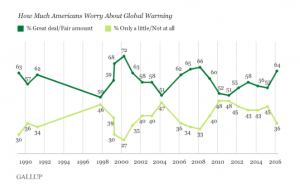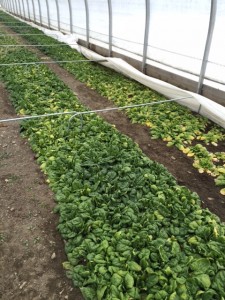Butterworks Farm is one of Vermont’s oldest certified organic dairy farms, and has a strong reputation for growing some of the finest organic grains in the state. The farm building complex and surrounding fields are situated on gently sloping fields near the border of Canada. A herd of Jersey cows produces milk which is processed on site into yogurt, kefir and rich Jersey cream for direct and wholesale markets.

Jersey cows, Butterworks Farm, photo credit: Suzy Hodgson, UVM Extension
Butterworks Farm leases and owns additional parcels in the surrounding area, including some floodplain fields. The farm has grown a diversity of whole and milled grains for regional markets, and animal feed and is currently transitioning to a 100% grassfed operation with a bedded pack system. Alissa White visited Butterworks in early April 2017 to talk to Jack Lazor about how he manages his production with the impacts of climate change in mind.
Climate Vulnerabilities
Regional climate change projections predict agriculture in the northeastern US will experience a variety of direct weather impacts, and indirect impacts as a result of climate change. For Butterworks Farm in northern Vermont, the site-specific vulnerabilities of climate change encompass potentially both direct and indirect climate change impacts.

Butterworks Farm. Photo credit: S. Hodgson, UVM Extension
Direct Climate Change Impacts
- Warmer temperatures overall,
- Longer warmer growing seasons,
- Precipitation increases,
- Extreme precipitation events,
- Increased flood damage and erosion,
- Severe wind and storm hazards,
- Elevated atmospheric CO2,
- Increased potential for drought.
Indirect climate change impacts lead to increases in:
- Weed competition and invasive species,
- Populations of damaging insects,
- Incidence of plant pathogens,
- Livestock heat stress, and
- Pressure from pathogens and parasites of livestock.
Adapted from Janowiak et al 2016 and Tobin et al 2015
Management goals
Jack and his family balance many goals and challenges when making decisions about managing their farm. Climate concerns fall into both short and long-term decision making at Butterworks, but at the forefront of farm decision making for their family at this time are long-term financial solvency and near-term intergenerational transfer of ownership. Climate change considerations are important, but auxillary to day-to-day management and long-term planning.
How do we manage climate change and weather-related risks at the field scale?
Jack implements a number of practices on the field, specifically, managing for flooding and controlling soil erosion. He has transitioned land which is particularly prone to flooding from grain production into permanent forage. “We’ve been farming this floodplain property for 20 years…Increased incidence of high water… could come any month of the year now… Then we only loose one cut out of three if there’s high water.” In previous years, the farm has used underseeding cover crops to limit erosion from high intensity rain events.
“We’ve been farming this floodplain property for 20 years… high water… could come any month of the year now…”

Jack Lazar, Butterworks Farm. Photo credit: Suzy Hodgson, UVM Extension
Jack attributes many benefits to crop rotations, including some that are directly associated with climate risks. His goal is to do less with tillage in all fields because he sees evidence of better soil quality and healthier plants without tillage. By minimizing tillage and keeping roots in the ground, he maintains soil health with organic matter of 8-9%.
At the field scale, Jack is focused on increasing soil health to buffer the impacts of drought, flooding and extreme precipitation. Cover crops are planted to help hold soil from erosive forces, and land which is particularly flood prone is being transitioned into perennial forages to protect soil.
Building soil biological health and organic matter levels has multiple benefits for the farm. Jack sees the soil health reflected in the plant growth, and in turn the health of his farm’s Jersey cows. Increased organic matter limits the damage of extreme precipitation and holds moisture in times of drought. In response to 2016 summer drought, Jack relied upon increasing his land base for forages and maintaining good rotational grazing practices. In contrast, grain production has been challenging financially as it’s prone to disease during wet summers and storm events. Overall, the farm’s trajectory is towards perennial forages and away from grain production.
Contributing Author: Alissa White, Research Specialist, Agroecology Livelihoods Collaborative (ALC)
Department of Plant and Soil Science, University of Vermont






